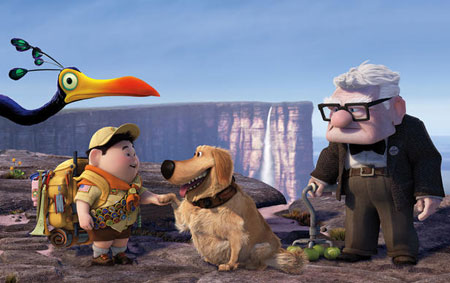Archives
June 30, 2009
A few random, unrelated observations about recent events:
- It’s hard to ignore the recent rash of celebrity deaths, most of which were unexpected and untimely. Within a 10-day span, we lost Philadelphia sports anchor Gary Papa (June 19), Ed McMahon (June 23), Farrah Fawcett (June 25), Michael Jackson (also June 25), and TV pitchman Billy Mays (June 28). What is this world coming to?
- One macabre yet admittedly funny side note — last Thursday night, just a few hours after confirmation of MJ’s sudden passing, my Quizzo team competed against a quartet that named themselves The Jackson 4. Ouch.
- Yesterday, Bernie Madoff (as in “made off with everyone’s money”) received a maximum 150-year prison sentence for his massive $13 billion Ponzi scheme that spanned nearly two decades. Since Madoff is already 71, I acknowledge that it’s pretty absurd to send him to jail until he’s 221 years old. And yet, the size of the punishment fits that of his crime, which utterly ruined thousands of lives.
- I find some fault with Madoff’s investors, though. They blindly trusted one individual to manage millions of dollars and never bothered to question or challenge his uncanny ability to deliver large returns every year without fail. Whether you prefer to invest in stocks, bonds, precious metals, real estate, or frozen concentrated orange juice, you should never expect such abnormally consistent, long-term results. But regardless, I’m glad to know that Madoff will spend the rest of his life in a cage, and I’m sure he’ll have the opportunity to trade stories with Kenneth Lay in hell soon enough.
- I rarely have anything good to say about Manny Ramirez, especially in the wake of his 50-game suspension for using artificial testosterone and a female fertility drug (!). But during his exile, the fact that he played a few games on the Dodgers’ AAA affiliate, the Albuquerque Isotopes — a team that takes its name from the minor-league Springfield club on The Simpsons — is totally cool.
[ No. 530 ]
June 28, 2009
In the FIFA Confederations Cup semifinals last week, the U.S. men’s soccer team made headlines with a stunning 2–0 upset over heavily favored Spain. Earlier today in the finals, Team USA jumped out to an early 2–0 lead, but Brazil scored three second-half goals en route to a 3–2 win and the tournament title.
As someone who has always failed to understand the appeal of soccer, I’m still happy for the American team’s surprising success this year. However, I must reiterate my doubt that soccer will ever truly catch on at the professional level in the U.S., at least enough to rank among American football, baseball, basketball, and hockey. Soccer fans insist that their sport will eventually gain widespread interest in the States, but their prediction has been wrong for at least 30 years and counting.
To quote Chuck Klosterman, who rejects the notion of soccer as “the sport of the future” in his hilarious pop-culture book, Sex, Drugs, and Cocoa Puffs:
We want to see domination. We want to see athletes who don’t look like us, and who we could never be. We want to see people who could destroy us, and we want to feel like that desire is normal. But those people don’t exist in soccer; their game is dominated by mono-monikered clones obsessed with falling to their knees and ripping off their clothes.
I concur. And we’re not going to adopt the metric system, either.
[ No. 529 ]
June 27, 2009
In a recent article in Slate (one of my favorite daily reads), author Fred Kaplan introduces us to his new book, 1959: The Year Everything Changed. The author rightly admits that it’s rather absurd to claim that a single year is more important than any other. Still, Kaplan’s write-up is interesting enough that I might just read his book in the near future.
As I pondered whether 1959 was truly revolutionary, I immediately thought of two excellent albums from that year that had brought huge mainstream attention to jazz: Miles Davis’ Kind of Blue, a mellow masterpiece that I play quite frequently, and the Dave Brubeck Quartet’s Time Out, a set of catchy melodies with unusual time signatures. I discovered both of these albums in a very influential music course during my senior year in college, and they have certainly changed my life for the better.
I’m sure Kaplan’s book covers 1959 in detail, but I was surprised that his Slate article failed to mention a pair of notable events from that year that altered the appearance of some American icons:
- Alaska and Hawaii both became states in 1959, and their entrance into the Union led to the current design of the U.S. flag. Surprisingly, the 50-star flag (1960–present) has since become the longest-running design in U.S. history; the 48-star version (1912–1959) is now a close second.
- Also in 1959, the U.S. Mint released the Lincoln Memorial cent, which replaced the previous wheat reverse design (1909–1958). Regrettably, the Lincoln Memorial version will be replaced this year with a set of four fussy designs to commemorate Lincoln’s 200th birthday, and yet another design (undetermined at this time) will follow starting in 2010.
[ No. 528 ]
June 17, 2009
For reasons that remain unclear to me, I am routinely underrepresented as a buyer of greeting cards.
On an annual basis, I struggle to find a remotely appropriate birthday or Christmas card for both of my sisters. Practically every card intended for one’s sister is bright pink, adorned with a hazy black-and-white photo of two young girls wearing frilly hats, and engraved with a variation on the message, “I’m So Glad We’re Sisters.” Apparently, card-buying brothers are a very rare breed.
Earlier tonight, I learned that Hallmark has concluded that most sons don’t purchase Father’s Day cards, either. In the local card store, I counted more cards under the completely absurd heading, “From the Dog — Humor” than those in the more predictable category, “Dad From Son.”
A few important lessons here. One, I might have to start making my own cards; Lord knows my hardwriting is good enough. And two, if you have ever bought a greeting card on behalf of your pets (and you know who you are), then I urge you to seek immediate mental counseling.
[ No. 527 ]
June 14, 2009
I’ve always admired clever roadside signs, and I happened to spot this gem on the way home from my parents’ house earlier this evening:

I mean, when your primary product is simply frozen water, how can you differentiate your business from the competition? By reminding your customers that ice is practically a health food — that’s how.
And I think it’s only fair to reward such wit by throwing these guys some free advertising. The sign pictured above stands in front of The Ice Butler in Malvern, Pa., so make sure to visit them for all of your low-fat ice needs.*
* Update: In response to my Facebook update that linked to this post, my friend Jim passed along another winner:
Nice — my fave was in front of the Wendy’s in Paoli — said “CLOSERS WANTED” but the “C” had gone missing. Can’t make this stuff up.
Actually, that particular Wendy’s location is very close to my house, and I would have loved to see that sign in person.
[ No. 526 ]
June 6, 2009
Last night, some friends and I went out to see Up, the latest release from Disney/Pixar and one of the best movies I’ve seen in the last few years. The film was hilarious and heartbreaking in equal measure; in fact, Up contained more unique characters and genuine emotion than most live-action films could ever hope to achieve, let alone deliver.

Up also continues a long tradition of stellar filmmaking by Pixar. I’ve watched most of their full-length films, and not one of them is even close to average; most are downright excellent. And I’m not the only one who raves about Pixar’s work. According to the normalized 100-point scale on Metacritic, the ratings for Pixar movies are consistently, astoundingly high. (As of this writing, Up has a combined rating of 88; the previous two Pixar films, WALL·E and Ratatouille, scored even higher with ratings of 93 and 96, respectively).
Granted, Pixar isn’t the only game in town; there are many other studios that produce successful movies with vibrant animation and amazingly lifelike characters. But Pixar has never skimped on one key ingredient: clever yet timeless storytelling. That’s what sets them apart, and the main reason why they’ve become the best movie studio, animated or otherwise, of our time.
[ No. 525 ]
Image credit: Yahoo! Movies: Up
